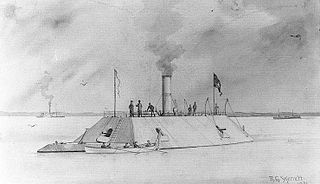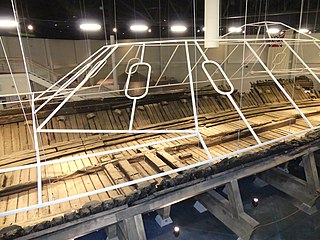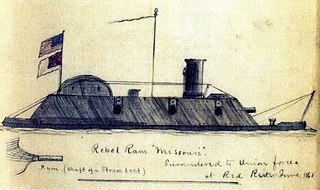
CSS Texas was the third and last Columbia-class casemate ironclad built for the Confederate Navy during the American Civil War. Not begun until 1864 and intended to become part of the James River Squadron, she saw no action before being captured by Union forces while still fitting out. CSS Texas was reputed to have been one of the very best-constructed Confederate ironclads, second only to CSS Mississippi.
CSS North Carolina was a casemate ironclad built for the Confederate Navy in 1863 during the American Civil War by Berry & Brothers at Wilmington, North Carolina at a cost of $76,000. She was placed in commission during the latter part of the year with Commander W. T. Muse, CSN, in command.

CSS Tennessee was a casemate ironclad ram built for the Confederate Navy during the American Civil War. She served as the flagship of Admiral Franklin Buchanan, commander of the Mobile Squadron, after her commissioning. She was captured in 1864 by the Union Navy during the Battle of Mobile Bay and then participated in the Union's subsequent Siege of Fort Morgan. Tennessee was decommissioned after the war and sold in 1867 for scrap.

CSS Baltic was an ironclad warship that served in the Confederate States Navy during the American Civil War. A towboat before the war, she was purchased by the state of Alabama in December 1861 for conversion into an ironclad. After being transferred to the Confederate Navy in May 1862 as an ironclad, she served on Mobile Bay off the Gulf of Mexico. Baltic's condition in Confederate service was such that naval historian William N. Still Jr. has described her as "a nondescript vessel in many ways". Over the next two years, parts of the ship's wooden structure were affected by wood rot. Her armor was removed to be put onto the ironclad CSS Nashville in 1864. By that August, Baltic had been decommissioned. Near the end of the war, she was taken up the Tombigbee River, where she was captured by Union forces on May 10, 1865. An inspection of Baltic the next month found that her upper hull and deck were rotten and that her boilers were unsafe. She was sold on December 31, and was likely broken up in 1866.

CSS Palmetto State was one of six Richmond class casemate ironclad rams built for the Confederate States Navy during the American Civil War. Completed in 1862, she defended Charleston, South Carolina and was burnt in 1865 to prevent her capture by advancing Union troops.

CSS Chicora was a Confederate ironclad ram that fought in the American Civil War. It was built under contract at Charleston, South Carolina in 1862. James M. Eason built it to John L. Porter's plans, using up most of a $300,000 State appropriation for construction of marine batteries; Eason received a bonus for "skill and promptitude." Its iron shield was 4 inches (102 mm) thick, backed by 22 inches (559 mm) of oak and pine, with 2-inch (51 mm) armor at its ends. Keeled in March, it was commissioned in November, Commander John Randolph Tucker, CSN assuming command.

CSS Richmond was the name ship of her class of six casemate ironclads built for the Confederate States Navy during the American Civil War. Completed during 1862 the ship was assigned to the James River Squadron where she mostly supported Confederate forces near Richmond, Virginia. She was burned in April 1865 to prevent her capture by Union forces.

CSS Columbia was an ironclad steamer ram in the Confederate States Navy and later in the United States Navy.
CSS Raleigh was a steam-powered Civil War casemate ironclad. She was fitted with a spar torpedo instead of an iron ram and was built in 1863–1864 by the Confederate States Navy at Wilmington, North Carolina. While she was being built her commander was Lieutenant John Wilkinson (CSN). She was put into commission on April 30, 1864 under the command of Lieutenant J. Pembroke Jones, CSN.

CSS Savannah was a Richmond-class casemate ironclad in the Confederate States Navy during the American Civil War.

CSS Muscogee was an casemate ironclad built in Columbus, Georgia for the Confederate States Navy during the American Civil War. Her original paddle configuration was judged a failure when she could not be launched on the first attempt in 1864. She had to be rebuilt to use dual propeller propulsion. Later renamed CSS Jackson and armed with four 7-inch (178 mm) and two 6.4-inch (163 mm) cannons. She was captured while still fitting out and was set ablaze by Union troops in April 1865. Her wreck was salvaged in 1962–1963 and turned over to the National Civil War Naval Museum in Columbus for display. The ironclad's remains were listed on the National Register of Historic Places in 1970.

CSS Neuse was a steam-powered ironclad ram of the Confederate States Navy that served in the latter part the American Civil War and was eventually scuttled in the Neuse River to avoid capture by rapidly advancing Union Army forces. In the early 1960s, she produced approximately 15,000 artifacts from her raised lower hull, the largest number ever found on a recovered Confederate vessel. The remains of her lower hull and a selection of her artifacts are on exhibit in Kinston, North Carolina at the CSS Museum, which belongs to the North Carolina Department of Natural and Cultural Resources. The ironclad is listed on the National Register of Historic Places.

The Neosho-class monitors were a pair of ironclad river monitors laid down in mid-1862 for the United States Navy during the American Civil War. After completion in mid-1863, both ships spent time patrolling the Mississippi River against Confederate raids and ambushes as part of Rear Admiral David Porter's Mississippi Squadron. Both ships participated in the Red River Campaign in March–May 1864, although Osage supported the capture of Fort DeRussy in March and participated in the Battle of Blair's Landing in April. Osage was grounded on a sandbar for six months after the end of the campaign while Neosho resumed her patrols on the Mississippi. The latter ship supported the Union Army's operations on the Cumberland River and provided fire support during the Battle of Nashville in December.

CSS Missouri was a casemate ironclad built by the Confederate States Navy during the American Civil War. Her propulsion machinery was taken from an existing steamboat, her armor was railroad T-rails, and she was armed with three captured cannon. She was difficult to steer and leaked badly. Additional equipment had to be added to bring allow her to reach her intended speed. Completed during 1863 on the Red River, she was trapped in the Shreveport, Louisiana, area by low water and never saw combat. The vessel's crew had desertion issues and some of her crewmen were pulled from the army. After traveling downriver for the first time, the ship was surrendered in June 1865 to the United States Navy—the last Confederate ironclad to be handed over—and sold in November.

CSS Tuscaloosa was an ironclad warship that served in the Confederate States Navy during the American Civil War. Construction began in May 1862, under a contract with Henry D. Bassett. Her engines were taken from the steamboat Chewala, and she was armored with 4 inches (10 cm) of iron and armed with four cannons. In January 1863, she was launched, and traveled down to Mobile, Alabama for service on Mobile Bay. Both Tuscaloosa and her sister ship CSS Huntsville were found to be too slow for practical use, and were relegated to service as floating batteries. Union forces captured Mobile in April 1865, and Tuscaloosa was scuttled on April 12, as she was unable to escape due to an inability to steam against the current on the Spanish River. Her wreck was discovered in the 1980s.
CSS Phoenix was a Confederate ironclad floating battery built at Selma, Alabama, from 1863–64.

CSS Nashville was a large side-wheel Nashville-class steam casemate ironclad built by the Confederates late in the American Civil War.
Charles H. McBlair was the eleventh adjutant general of Maryland. He was an officer in the United States Navy, and during the American Civil War commanded a number of Confederate warships.

The Huntsville-class ironclads consisted of two casemate ironclads ordered by the Confederate States Navy in 1862 to defend Mobile, Alabama, during the American Civil War. Completed the following year, they used propulsion machinery taken from steamboats, and were intended to be armored with 4 inches (102 mm) of wrought iron and armed with four cannons. Both CSS Tuscaloosa and her sister ship CSS Huntsville were found to be too slow for practical use, and were relegated to service as floating batteries. Union forces captured Mobile in April 1865, and the sisters were scuttled on April 12, as they were unable to escape due to an inability to steam against the current on the Spanish River.














